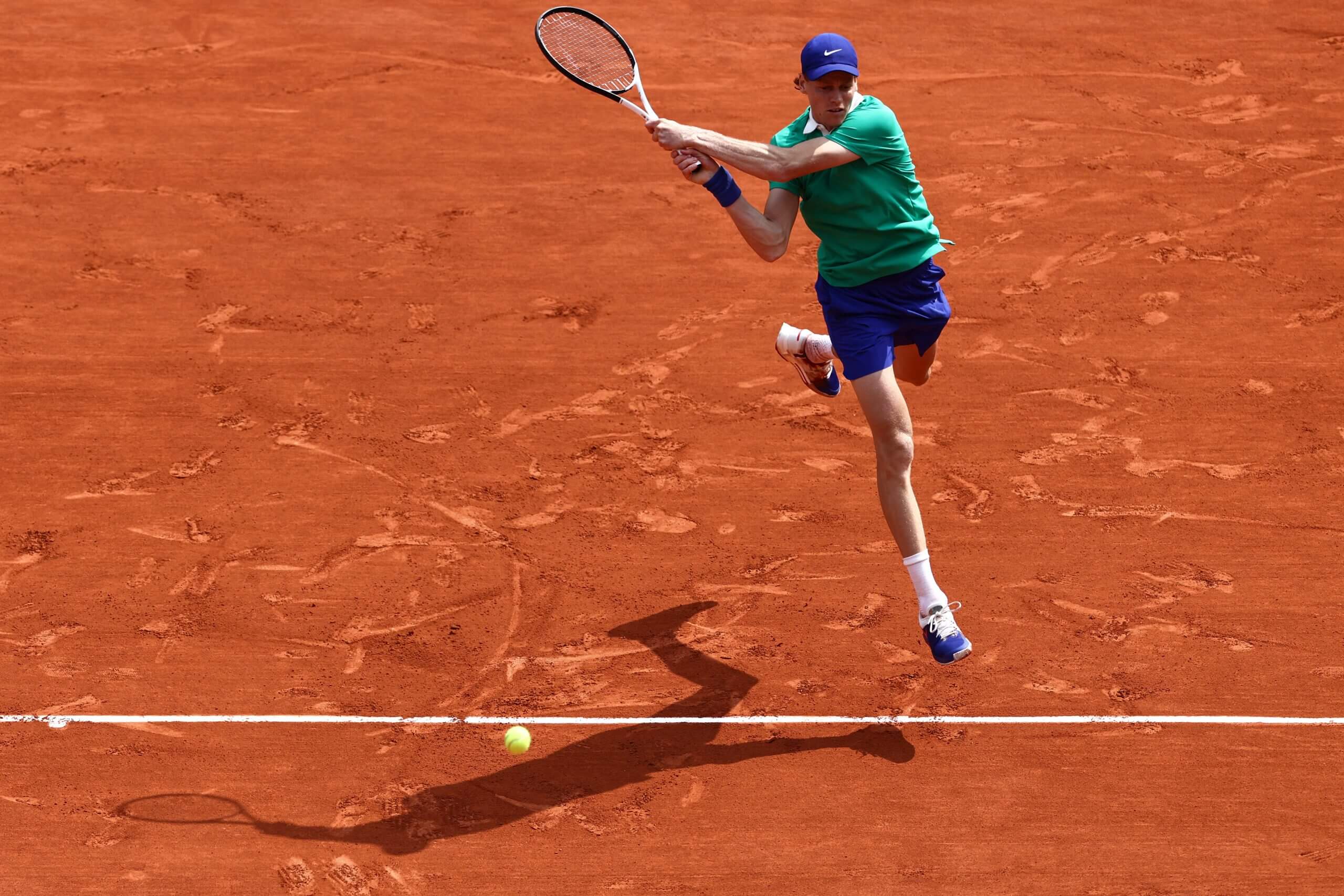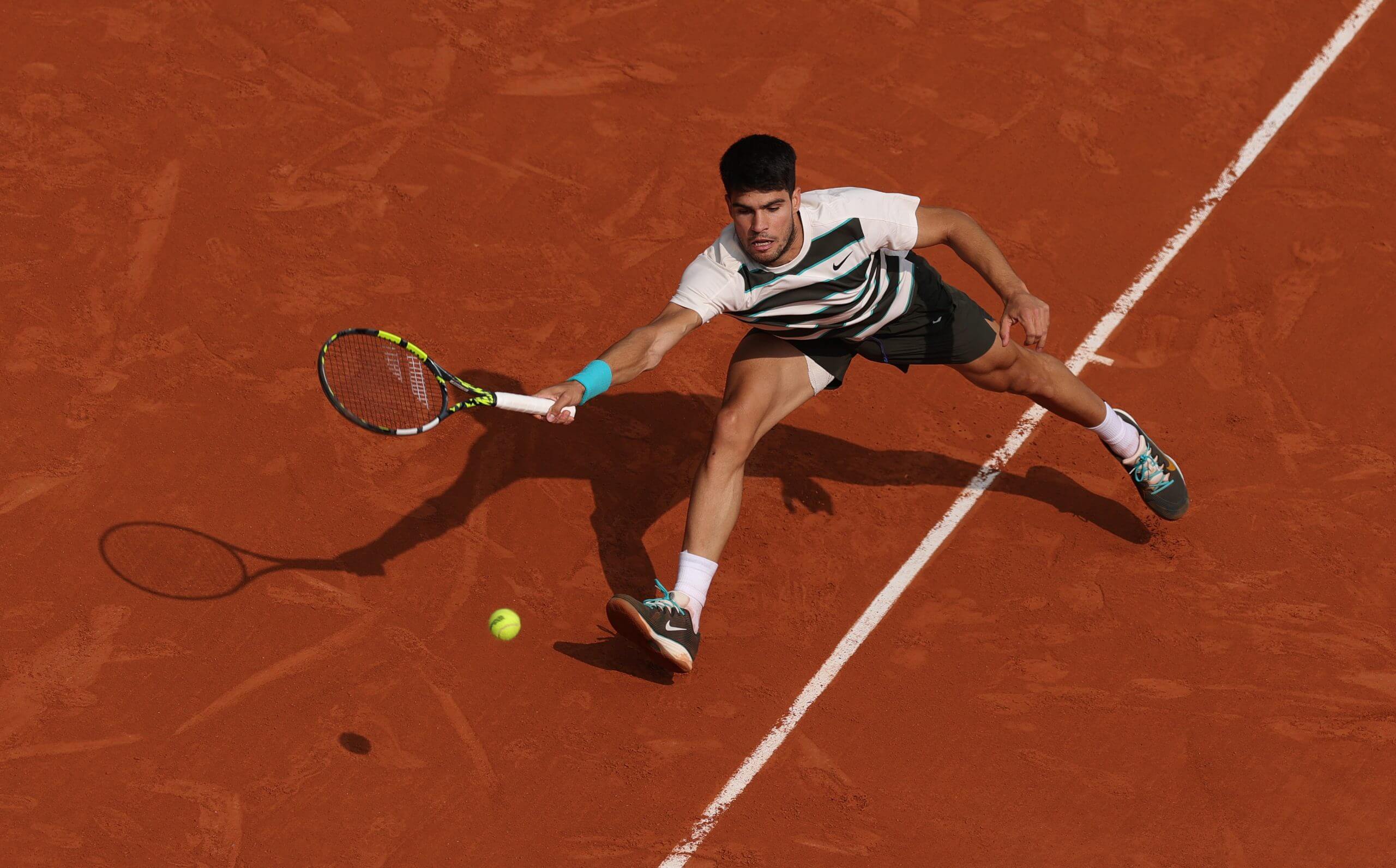
Follow live coverage of the French Open
ROLAND GARROS, PARIS — Carlos Alcaraz beat Jannik Sinner 4-6, 6-7(4), 6-4, 7-6(3), 7-6(2) in the French Open final at Roland Garros Sunday.
The No. 2 seed prevailed over the No. 1 seed in an intense, fast-paced match that turned into a tennis psychodrama as it stretched into its sixth hour and evening fell across the Paris clay. It was ultimately decided by Sinner’s dominance on short points, Alcaraz’s new-found ability to impose his variety, and one of the greatest surges of the Spaniard’s young career. It enshrines this young rivalry’s place in global sport.
Advertisement
It is Alcaraz’s fifth Grand Slam title and his second at the French Open, while this win is his first comeback from two-sets-to-love down in his career.
It takes Alcaraz and Sinner’s head to head to 9-4 in the Spaniard’s favor, and extends his winning streak over his nearest rival to five matches.
The Athletic’s writers, Charlie Eccleshare and Matt Futterman, analyze the final and what it means for tennis.
A tennis psychodrama between the two new stars of the sport
Having fended off three match points, Alcaraz found himself in the position Sinner had been the previous set: serving at 5-4 for the French Open title.
Against a physically ailing opponent, this final was surely going to get a conclusion at last. Instead, Sinner somehow found some extra reserves and took advantage of Alcaraz’s nerves to break back to 15. When Sinner chased down a drop shot to earn the break points, Alcaraz hadn’t even moved forward, so sure was he that he had won the point.
Court Philippe-Chatrier was stunned, and from there the match descended into a stunning psychodrama that enshrined this young sporting rivalry’s place in the global sporting world. None of this had seemed possible at the start of the set, when Sinner could barely move. It was as though he was somehow back from the dead.
The match was back level and impossible to call again. Alcaraz got to deuce on Sinner’s serve, but he couldn’t get the break he needed, and so had to serve to stay in the match having minutes before been serving for the title.
Things then went supersonic. Sinner smashed a forehand at Alcaraz, but the Spaniard somehow got in the way of it with a volley for 15-0. Sinner responded and won the next two points — the second an angled half-volley to make his rival blush — to leave himself two points from the title.
Advertisement
How was he doing this? The same could be said of Alcaraz, who moved to 40-30 and avoided being championship point down again with a ridiculous forehand defensive shot followed by a flicked backhand winner. Even better was to come when Alcaraz, from deep behind the baseline, found the strength to rip a backhand passing shot away for a winner.
That took the match into a tiebreak and ended a three-game drama that transposed into one of the great surges of Alcaraz’s career. It may prove to be one of his greatest.
Alcaras got to an early lead with two big forehands across the court and a Sinner ball that flew long. Then he took a Sinner drop shot grab out of the air on the full run to his right and and smacked it deep into the open clay. Another forehand long and Alcaraz was up 5-0, halfway home.
Was there another escape for Sinner? Not this time. He missed a backhand before Alcaraz sizzled one down the line for a 7-0 lead. After all the tension of the previous five and a half hours, Alcaraz found his ceiling, which is peerless in the sport and borderline unplayable. A match that had been defined by Sinner’s impossible floor, obliterating the ball with enough safety that it lands well inside the lines, had been stolen away from him.
There was time for one final miracle – a running forehand down the line that was too ridiculous for words. Alcaraz collapsed into the clay, a champion again.
Matthew Futterman and Charlie Eccleshare
The story of Carlos Alcaraz’s great escape
Tennis fans will be watching tapes of five points from the 2025 French Open final 25 years from now.
The match seemed so lost, it was almost silly to consider what might happen when Alcaraz stepped to the line to serve at 0-40, 3-5 in the fourth set. The celebration in Italy was about to explode.
Then came a long rally, the kind that that Sinner was on the short end of for much of the afternoon. He went long with a ground stroke. Interesting, but he had two more match points and then a chance to serve it out. Then he tried to jump on a second serve, and sent the backhand long. Hmm.
Advertisement
On the next point, Sinner seized control, moving into the court, getting to a spot to set up a kill shot, but when he pulled the trigger on his forehand, it went into the net. Alcaraz had his lifeline and whipped up the crowd, promising them more tennis if they could carry him to this most unlikely rise from the abyss.
An ace and a forehand down the line to the postage stamp later, Alcaraz was alive. When he was taken to the fifth-set tiebreak, it looked as if he had wasted his resurrection. Instead, the Spaniard produced a tidal wave that surpassed even his great escape.
Matt Futterman
How did Sinner dominate the most common type of point in tennis?
Anyone might have predicted that Jannik Sinner would have the edge on short points. He’s got the bigger serve and induces more errors on return than most top players and more easy second shots as well.
Through the first set and into the start of the second, Sinner more than doubled Alcaraz’s tally on points of four shots or fewer, winning 32-14. For shots that lasted longer than four shots, Alcaraz was in the lead 23-11. Sinner’s short-point edge quickly climbed to 38-14 over the first three games of the second set, when he took early command.
Those numbers provided a nice snapshot of each player’s strategy coming into the match. Alcaraz wanted to get into points, especially on Sinner’s serve. He wanted to move the Italian across and in front of the baseline. Sinner wanted to play first-strike tennis and avoid the points in which it feels like Alcaraz is controlling his opponent like a puppeteer.

Jannik Sinner stepped into the court behind his serve and forced the issue against Carlos Alcaraz to take his opponent’s strategy away. (Thibaud Moritz / AFP via Getty Images)
The dichotomy on point length gave Alcaraz that opportunity, but given the effectiveness of Sinner’s serve — and the laws of elite tennis, in which short points make up the majority of points played — there were so many more short points than longer ones that Alcaraz’s potential advantage was quickly wiped away. By the start of the third set, Alcaraz was still up in the longer points, 34-29, but Sinner’s advantage in the shorter ones was at 61-48. Sinner was playing over 60 percent of the match in a game state in which he held an overwhelming advantage.
Advertisement
Even as Alcaraz wiped out Sinner’s two-set lead in his stirring comeback, Sinner’s advantage in the short points held firm.
It’s no coincidence that during the peak of his domination, he was winning 66 percent of points on his first serve, compared with a little under 60 percent for Alcaraz. Sinner switched from a platform (feet apart) stance in his serve, to a pinpoint (feet together) launch two years ago. He soon became the world No. 1, though beating Alcaraz remained a struggle. These two players are a level above the rest of the tour, evenly matched rivals in their own galaxy. But if there is one notable gulf, it is between their serves. Alcaraz needs to close it.
Matt Futterman
The key to beating Carlos Alcaraz, and how Sinner managed it — until he didn’t
Ask any player who has done it on the biggest stages in tennis. So much of beating Alcaraz lies in finding a way to snuff out the surges that he uses to steamroll an opponent, whether he’s ahead or behind. Sometimes they start with a single circus-like point, that ends with a miraculous passing shot on the run, or a crazy chase after a lob that no one else would think about sprinting after.
On Sunday, the first surge came an hour and three-quarters into a match that had turned into one-way traffic for Sinner, who was serving for a two-set lead at 5-3. But suddenly Alcaraz had a 0-30 lead, and Court Philippe-Chatrier came alive for the first time. The fans were chanting Alcaraz’s name, begging him to make this a match.
Alcaraz obliged a couple of minutes later, pulling Sinner into two longer points, the kind that were going his way for most of the afternoon. Sinner got sloppy, committing two errors, giving Alcaraz and the match a breath of life. On the changeover he pumped his fist to the crowd, as much for himself as for them.
Then came one of his best games of the afternoon. He opened the court and twisted balls into the open space. At one hour and 55 minutes, the set was tied. It seemed like the match had turned in 10 minutes.
But Sinner got to this match by snuffing out a similar surge form Novak Djokovic in the second set Friday night. Djokovic had the crowd and the moment. Sinner played clinical tennis and smote the danger.
In this case, Sinner, played the right tennis at the right time, helped along by some luck that allowed a backhand down the side to nick the outside of the line. Into the tiebreak they went, and it was more of the same for Sinner while Alcaraz reverted to the errors, some on low-percentage shots, that had been plaguing him during much of the first two sets.
Advertisement
The most ill-chosen one was an attempt at an inside-out drop shot from behind the baseline as he danced backwards into the back corner with enough time to rip an inside-in forehand. It floated out to give Sinner a 5-2 lead in the tiebreak, and four points later the Italian was up two sets to one. What had looked like a classic Alcaraz takeover had been smothered like a tiny brushfire.
It took longer to snuff out the next one, which started when Alcaraz broke Sinner in the third set for 3-1. It was a part of a four-game winning streak that Alcaraz rode to capturing the third set, and it lasted through the first half of the fourth. Alcaraz played his best tennis of the afternoon, sliding aces out of Sinner’s reach and unleashing his forehand into open spaces.
But in the seventh game of the fourth set, Sinner shut down any ideas Alcaraz might have had that this would go the distance. He slid a drop shot nearly parallel to the net to get within two points of a decisive break. He stood firm enough in the next two rallies to induce the errors from Alcaraz and looked to be on his way.
He wasn’t, because Alcaraz was about to unleash maybe the biggest surge of his career. He won 13 of the next 14 points to climb from 3-5, 0-40 down to 6-5 up. Sinner pushed it to a tiebreak, but after falling down 0-2, Alcaraz cranked out a couple of aces on his way to winning seven of the last eight points.
Everything the world needed to know about what would come unfolded while groundskeepers prepared the court for the fifth set. With “Sweet Caroline” cranking on the sound system, Alcaraz ran to the crowd behind the baseline with his fist in the air as Sinner remained seated on his chair, trying to figure out some way to stifle all this.
In the end, he found it, until the one last Alcaraz rise that proved impossible to quell.
Matt Futterman
In a matchup defined by rhythm, Sinner played the baseline before being swept into a dance
If the biggest edge Sinner has on Alcaraz is the serve, the biggest edge Alcaraz has on Sinner is rhythm. It’s not just the variety that Alcaraz possesses, like the drop shot and general comfort in the forecourt that the Italian is adding to to his game. Alcaraz can maneuver the ball and change the cadence of a match like no other elite player. Some lower down the tour — Corentin Moutet, Alexander Bublik — are even greater masters of disruption and improvization, but Alcaraz is the maestro.
Advertisement
So perhaps Sinner’s greatest achievement Sunday was stopping that from happening for large swathes of the match. Sinner dictated the terms of play, and ensuring that the match was a contest of intense, fast, but generally metronomic rallies. Alcaraz, who so often is the person dictating, was left needing to get his opponent out of his favored rhythm, trying to make the patterns of play more unpredictable. He tried, but Sinner was able to stay tight to the baseline and play a match more like something on a hard court: the surface where Sinner is borderline unbeatable. By his own admission, it’s the kind of tennis he’s been playing all clay-court season, leaving defeated opponents in his wake.

Carlos Alcaraz couldn’t set the terms of the match against Jannik Sinner. (Julian Finney / Getty Images)
For the first two sets, Sinner’s consistent hitting and aggressive court position prevented Alcaraz from getting on top of the rallies and bringing his lethal drop shot regularly into play. When Alcaraz did use it, Sinner was too far forward to make it effective. By the end of the third set, Alcaraz’s drop shots to points played percentage was the lowest it had been all tournament.
But as the match ticked into its fourth and fifth sets, it was Alcaraz who took over. By the fifth, Alcaraz was swinging Sinner across the baseline and punishing him with inside-in drop shots, as the Italian’s failed sprint for the finish line took the energy out of his legs. Having withstood his opponent’s most lethal weapon for so long, the intensity that had taken Sinner to the cusp of the title left him powerless to stop the coup de grâce — until the one he caught up in the fifth set to prolong the match.
By the end, Alcaraz had hit more drop shots than during any other match in the tournament.
Charlie Eccleshare
How, and why, Sinner tried to sprint to the finish line
Sinner’s tennis is often compared to Djokovic, but there’s something about his mentality that also resembles the 24-time Grand Slam champion.
Having been broken to love to lose the third set, he looked over to see a grinning Alcaraz with his finger to his ear. The momentum was with the Spaniard, and that gesture can be the equivalent of the emperor’s thumbs down in ancient Rome. A loose Alcaraz, riding a wave of positivity and feeling the noise of the crowd, is one of the most terrifying sights in tennis.
Advertisement
But like Djokovic, Sinner is extremely adept at shrugging off disappointment to lock back in. He began the fourth set with renewed purpose, and though he missed a break point on Alcaraz’s serve at 1-1, he was holding easily himself and keeping the pressure on his opponent.
Alcaraz, knowing one misstep would almost certainly be terminal, lost his serve to love to give Sinner a 4-3 lead with another loose game. Sinner put the rhythm of the match back on his terms, pinning back his opponent’s surge.
How much Sinner felt he had to get this done in four sets because of his recent three-month suspension, his lack of matches, and his poor record in long matches — he was 6-9 in five-setters and had lost all six longer than three hours and 50 minutes prior to this final — is uncertain.
But Alcaraz wasn’t going to let him streak away with the Coupe des Mousquetaires that he won last year. He saved three championship points down 3-5, then broke Sinner at 4-5 down with the Italian serving for the title, to force the match into a tiebreak that had seemed impossible only a few minutes earlier.
Curiously, the clock ticked beyond three hours and 50 minutes while Sinner was serving for the match, which made the fact that Alcaraz had kept things competitive in the face of a second-set rout a couple of hours earlier significant. Alcaraz had trailed 1-4, 40-40 on his serve; had Sinner won that set 6-1 or 6-2 rather than 7-6, he’d have had half an hour less in his legs. Coco Gauff said after beating Aryna Sabalenka in Saturday’s women’s final that extending the first set of their match had been an important factor in her ultimately outlasting the world No. 1.
Alcaraz certainly looked the fresher in the tiebreak, and the sprint finish Sinner had been hoping for disappeared. This had become a long-distance race again, and it was Alcaraz who had the edge. He went down 0-2, then up 4-2, conjuring memories of the Beijing Open final last fall, when Sinner led a tiebreak 3-0 before Alcaraz won it 7-3.
Alcaraz took this tiebreak by the same scoreline and the match went into a fifth set. From there, Sinner was at the point that his sprint for the line had been designed to avoid. Again, it proved the point of no return.
What did Carlos Alcaraz say after the final?
We’ll bring your their on-court quotes and press conference reflections as they come in.
What did Jannik Sinner say after the final?
We’ll bring your their on-court quotes and press conference reflections as they come in.
Recommended reading
(Top photo: Julien de Rosa / AFP via Getty Images)
This news was originally published on this post .








Be the first to leave a comment